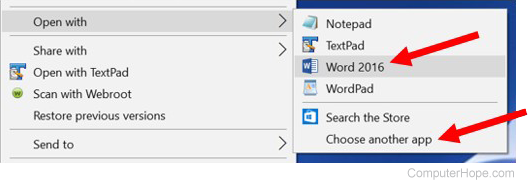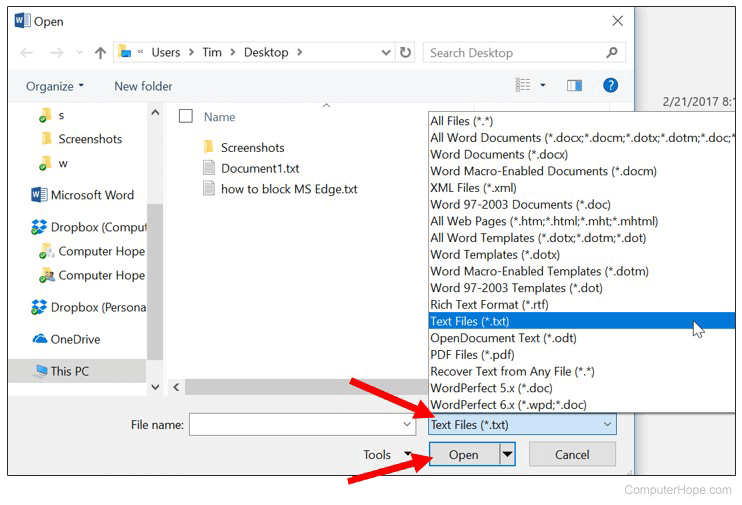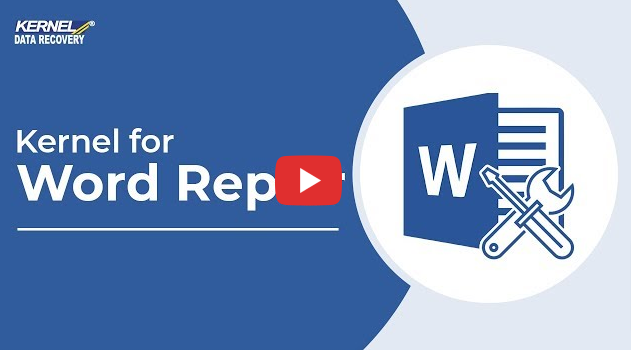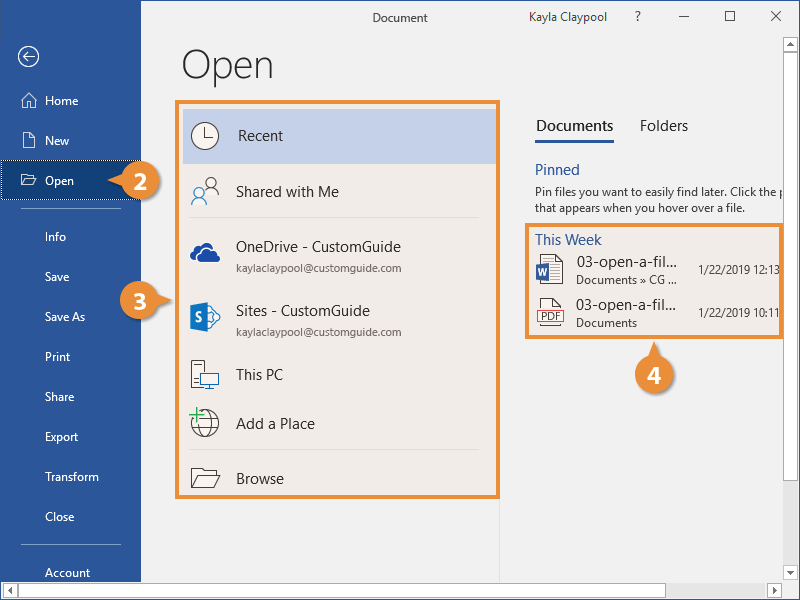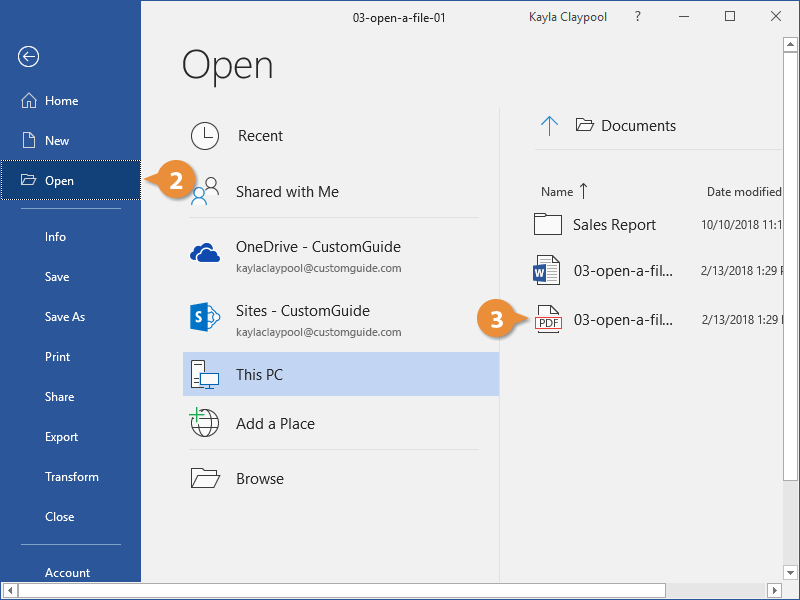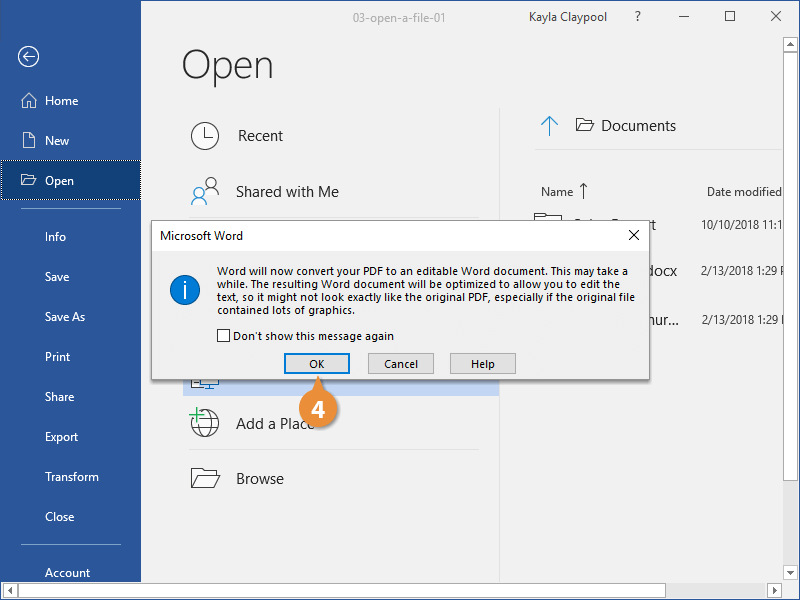You can open or import a surprising number of file formats into Microsoft Word. Not to be confused with file formatting, which—in most programs—refers to the design of a page, file formats are little encoded programs that tell computers how to handle the files used in specific programs. Look for the three or four letters after the period that follows the file name—that’s the file extension revealing the associated program.
Not all file formats are compatible with all programs, especially those that are radically different, such as a word processor vs. a programming language, or a music file and a graphic file. However, many programs that are similar, such as Word and WordPerfect, are generally compatible.
Word is flexible enough even to bring in spreadsheets from Excel or slides from PowerPoint, as well as text from other word processors. Weird line breaks and other issues can arise, however, so follow these instructions for the smoothest results.
Notice how many file formats Word can open with its (hidden) built-in conversion utility.
1. Select File > Open
2. Click the down arrow beside the File Types list box (above the Open and Cancel buttons)
3. Select All Files from the list, and Word displays a long list of conversion-compatible file formats.
Select All Files from the MS Word file format list
4. Choose a format from the drop-down list—for our example, we’ll choose Text Files (TXT).
5. Navigate to the appropriate folder. Word displays a list of all the .TXT files available in the target folder.
6. Select the applicable file, and click Open.
7. If the text encoding is questionable, Word displays a dialog that asks you to choose the correct one (such as Windows Default). Click the appropriate button, then click OK, and the text file opens.
Choose the Text Files–TXT format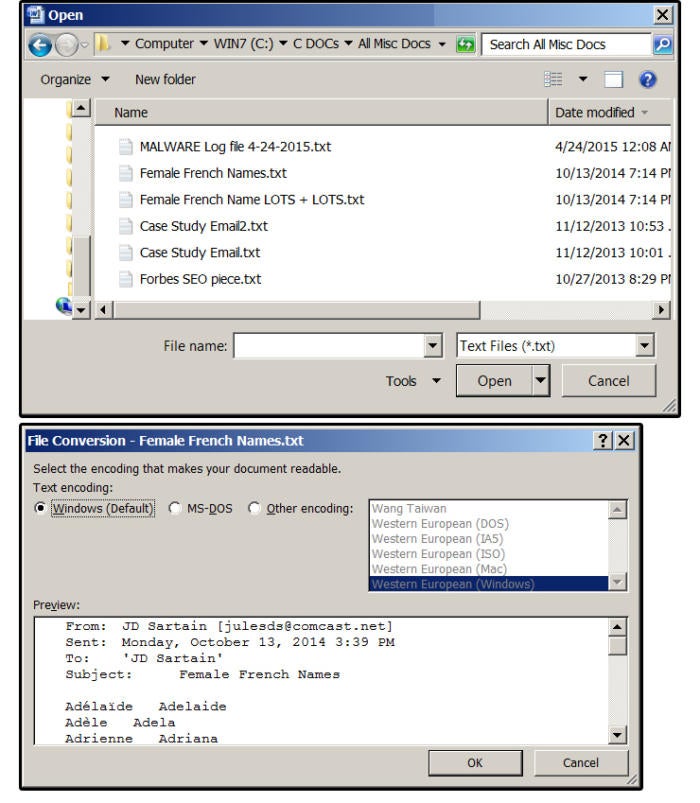
Note: The first line on the All Files list says “All Word Documents,” which are NOT All Word documents but, in fact, all documents that can be opened with Word’s (behind the scenes) conversion utility, such as HTML, HTM, XML, ODT, PDF, and several more. For example, if you save your Word document as a webpage (File > Save as Web Page), Word uses its (hidden) conversion program to automatically convert your document page to an HTML webpage, and vice versa.
8. ODT files are part of the Open Document Format (ODF) files, which are XML-based, Open Source file formats. .ODT files are for word processing programs. Also included are .ODS for spreadsheets, .ODP for presentations, .ODG for graphics, and .ODF for formulas or other mathematical equations.
If you want to open an ODT file, it’s at the end of this first line that says All Word Documents (far right), which is not visible on most monitors. So, scroll down the All Files list and select ODT (Open Document Text) from the drop-down list of files.
9. The All Files list also shows Text files (.TXT), which includes ASCII files, Rich Text Format files (RTF), and Word Perfect files versions 5x through 9x (.DOC, .WPD, .WPS). Again, just select the format you need, navigate to the appropriate folder, and select a file from the list.
10. What about the Adobe Acrobat PDF file format? The PDF format is available on the All Files list in versions 2013 and 2016. Prior Word versions did not provide this option. If you don’t have Word 2013 or 2016, you can export the file to Word from Adobe Acrobat; however, older versions and some Reader versions do not provide this feature. But you can save your Word document as a PDF file (since Word 2000). Just choose File > Save As and select Adobe PDF from the submenu.
Save As Adobe PDF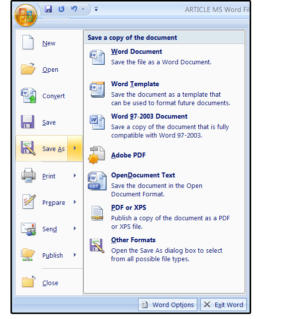
How to open an Excel spreadsheet in Word
1. If you want to open an Excel spreadsheet in Word, first confirm that the spreadsheet is smaller than your screen (that is, no wider than your Word document minus margins). Otherwise, the cells will wrap to the next line and create a visual mess. You can change the margins or change the page orientation to landscape (Page Layout > Orientation > Landscape), and that will accommodate a few more columns. Or, make the columns in Excel smaller.
2. The easiest way to get a spreadsheet into Word is to highlight the spreadsheet in Excel, then copy and paste it in at your cursor’s location.
3. Another (more complicated way) is to position your cursor inside the Word document where you want the Excel spreadsheet to drop in.
4. Select Insert > Object > Object (from the Insert > Text group, click Object, then Object again).
5. In the Object dialog box, select the Create from File tab and then browse to the file’s location.
6. Select the appropriate file from the folder’s list and click Insert. The Object dialog box appears again. Click the checkbox Link to File if you want to link to the inserted spreadsheet file, so any changes you make on the spreadsheet are automatically updated in your Word document. Double-click anywhere on the inserted spreadsheet to open and edit the Excel file.
g. If your spreadsheet is too large to paste into Word, or if you’d prefer not to display the spreadsheet but still want others to see it and/or access it, click the checkbox Display as Icon. When you click the icon, notice the hint at the bottom of your screen. It says: “Double-click to edit the Microsoft Excel worksheet.”
04 Link to File or Display as Icon JD Sartain / PC World
Note: You won’t see any changes until you save both files, then re-open your Word document.
How to open PowerPoint slides in Word
1. Open one of your PowerPoint slideshow presentations.
2. Current versions: Select File > Export > Create Handouts, then press the Create Handouts button. Older versions: Select File > Publish > Create Handouts in Microsoft Word
3. All versions 2007–2016: The Send to Microsoft Word dialog box opens.
4. Click the radio button for one of the five formats you prefer, such as Notes Next To Slides, or Notes Below Slides.
5. Next, choose Paste or Paste Link.
Create Handouts in Microsoft Word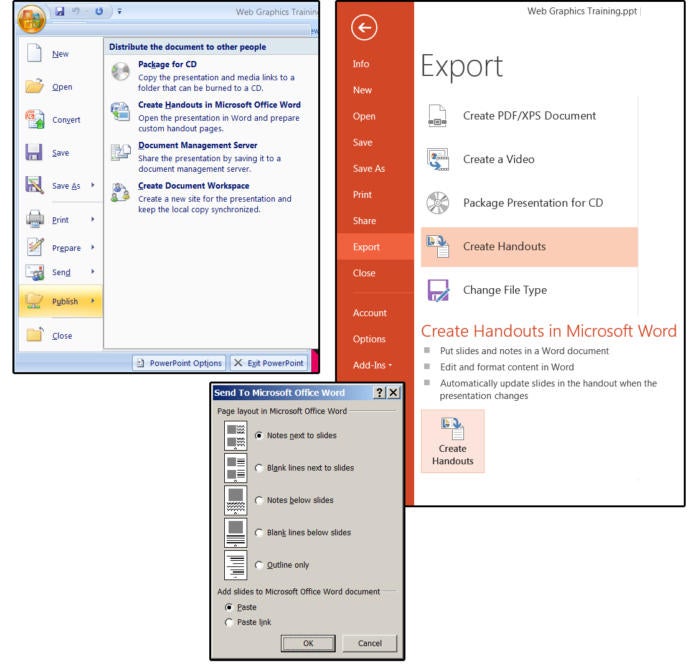
6. Both Paste and Paste Link open Microsoft Word and paste all the slides from your presentation into Word. Paste places the larger slides on separate pages. Paste Link pastes several smaller slides on each page.
7. Paste allows you to edit the slides in Word (double-click the slide). Link opens PowerPoint and allows you to edit the slide in PowerPoint (also, double-click the slide). You can also edit the text, titles, fonts, page layout, and more in Word to customize your handouts for each audience.
Paste Link or Paste PowerPoint slides into Word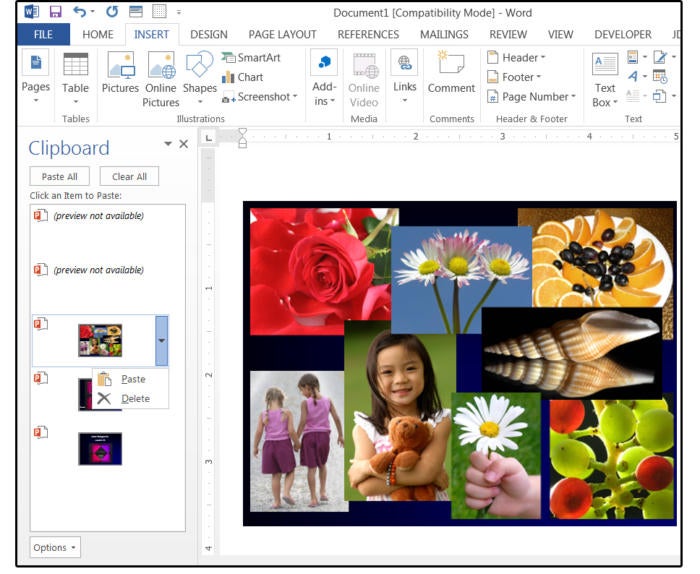
8. Once satisfied with your changes, choose File > Print, then click the Print button to make paper copies of your handouts for distribution.
9. You can also Copy and Paste the slides from PowerPoint to Word. Just open both programs, select the slide you want to copy from PowerPoint to Word and choose Home > Copy (or Ctrl+ C); then in Word select Home > Paste (or Ctrl+ V). But, this only works for one slide at a time.
07 Double-click to edit Microsoft PowerPoint slide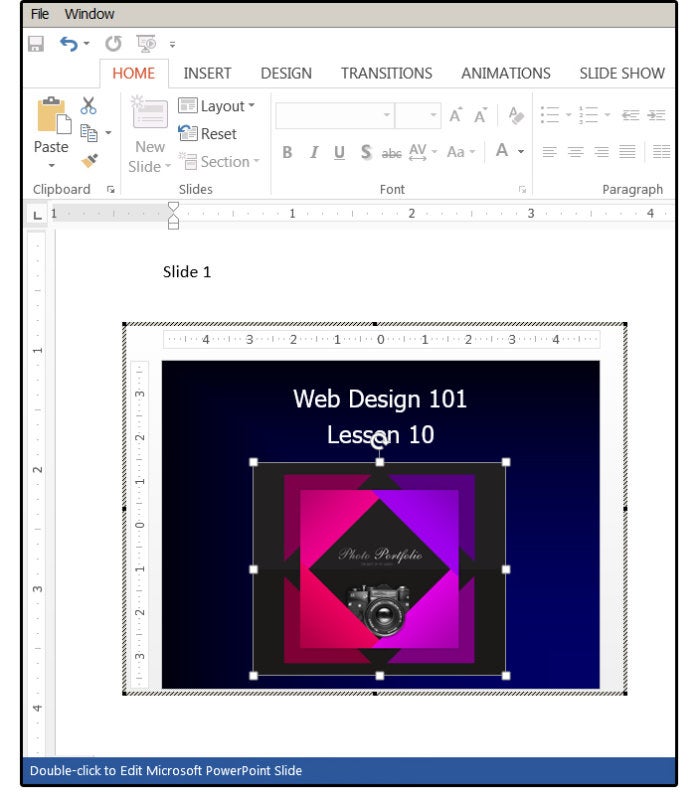
Important Note: There are numerous articles on the Internet that instruct users how to copy and paste multiple slides (as opposed to the entire slide show presentation) from PowerPoint into Word. I have researched and tested this thoroughly and, using the Shift key to select a range of consecutive slides (1, 2, 3, 4, 5) or using the Ctrl key to select a range of non-consecutive slides (2, 4, 8, 9, 11) does not work. Every test (using many different methods) failed to copy and paste multiple slides. Each time, PowerPoint only copied one slide at a time (the first slide selected in the range you defined). I tested this process on PowerPoint/Word versions 2007, 2003, 2010, 2013, and 2016 and it failed on each of these versions. But there is a work-around.
Copy/paste multiple slides from PowerPoint to Word
1. Open Word and PowerPoint. In Word, open the clipboard: Under the File tab, click the tiny arrow beside Clipboard.
2. Go back to PowerPoint and select the first slide you want to copy from PowerPoint to Word, then press Ctrl+ C.
3. Still in PowerPoint, select the next slide you want and press Ctrl+ C again. Switch back to Word and notice that there are now two slides in your Clipboard.
4. Back to PowerPoint: Select the next slide and press Ctrl+ C, then another slide and press Ctrl+ C again.
5. Stay in PowerPoint until you have copied all the slides you want from this presentation into your Clipboard. But remember, you must select and copy one slide at a time.
6. When finished, move back to Word. Check to ensure that all your slides are in your Clipboard, then click the Paste All button.
08 Copy and Paste multiple slides work-around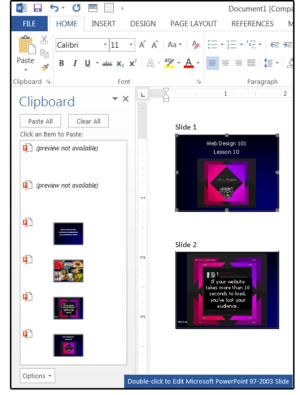
Note: Go directly to Word after you have copied all of your slides. If you type or copy anything else, it will show up in Word’s Clipboard, (which you can always delete). Also, don’t worry if the Clipboard fails to display some of your slides (and says Preview Not available). It’s just a memory thing. They paste into your document without issue.
7. You can also paste individual slides one at a time. Hover over the target slide in the Clipboard and click the down arrow. A drop-down list appears that says Paste or Delete.
If you select the Paste All button at the top of the Clipboard, the slides will paste into the document one after the other, with no space in between. Scroll down through the pages and either enter a line/paragraph break between slides, or enter a page break between slides if you want only one slide per page.
How to import graphic files into Word
This one is easy. Just copy and paste, or Select Insert > Picture and choose an image from an internal or external source. You can also select Insert > Clip Art and chose an image from the Internet.
Word uses file format converters to open and save documents in different formats. The most commonly used converters are installed with Word by default— unless you or your administrator choose to make them unavailable on your computer.
If you want to convert a document to a different format so that you or someone else can open it in another program or in an earlier version of Word, you can select that file format when you save the document.
If you want to open or save in a format that’s not installed by default, you may need to install additional converters.
The converters that come with Office Word 2003 allow you to do one or all of the following:
- Open a file that was created in another program.
- Save a file so that it can be opened in another program.
- Open a Office Word 2003 document in another program.
Opening and saving files in various formats without a converter
Word can open and save files in many formats apart from its default format (.doc), without the use of a converter.
Formats Word can open directly
- .doc
- The default Word document format.
- .dot
- Word template format.
- .htm, .html
- Web page in HTML format.
- .mht, .mhtml
- Web page in single file Web page (also known as Web archive) format.
- .xml
- Extensible Markup Language (XML) format.
- .rtf
- Rich Text Format (RTF); contains formatting instructions that other programs, including compatible Microsoft programs, can read and interpret.
- .txt
- Plain text format: contains no text formatting.
Formats Word can save directly
- .doc
- The default Word document format.
- .dot
- Word template format. Word applies all formatting and other attributes in the template to any new document based on the template.
- .htm, .html
- Web page in HTML format. Preserves Word document properties so that HTML documents retain Word-specific features if they are later saved back to Word document format.
Note You can also save a document in a filtered HTML format that removes the Word-specific HTML encoding (Web Page, Filtered).
- .mht, .mhtml
- Web page in single file Web page (also known as Web archive) format.
- .xml
- Extensible Markup Language file.
- .rtf
- Rich Text Format; converts formatting to instructions that other programs, including compatible Microsoft programs, can read and interpret.
- .txt
- Plain text format; contains no text formatting. Converts all section breaks, page breaks, and new line characters to paragraph marks. Allows you to select the ANSI character set or to use the encoding standard that you choose. Use an encoded format when you share documents with people who use system software in another language.
Changing the default file format
If you always save documents in a different format— for example, if you need to share all the documents you create with co-workers who are using a previous version of Microsoft Word— you can change the default file format Word uses to save new documents (Tools menu, Options command, Save tab). This setting affects only new documents you create. Word saves existing documents in the same format they were opened in.
The Confluence of Technology, Social Media and Frugality
The Writer’s Guide to Word Processing File Formats
The Essential Exchange Formats for Writers
Plus How to Rescue Old Files & Preserve Your Writing
[dropcap color=”#e07f00″ boxed=”no” boxed_radius=”8px” class=”” id=””]I[/dropcap]n our previous post, we explored a variety of writing and creativity tools. All of them are capable of importing and exporting information in a variety of formats. But there are so many formats that confusion can set in easily.
Frugal Guidance 2 to the rescue! Here are the main file formats that writers need to know about and the various different names that they go by. We also have some tips for rescuing old, old word processing files and a few ideas for saving your work for posterity.
Plain Text Document
Most apps call this simply a text file. It uses the extension (.txt). There is no formatting. No graphics. Just text, which means you can import it into any writing app on any system (PC, Mac, Linux, iOS, Android, and anything else you can find out there, including legacy systems). If you need to open your file on your phone, your iPad, or your office computer, this will work. WordPad (see our previous post) also lets you save a file in a text format for old DOS editors, too.
Text files are much more popular for writing and editing on the Mac and Linux than on Windows systems, but they work on all platforms.
RTF
RTF or Rich Text Format is an older but flexible Microsoft Word format that dates back to 1987. It can be used to exchange formatted text and many graphics between most word processors. It’s a good Swiss-Army-Knife-type tool for exchanging files between applications when you don’t want to lose all your formatting as you would with a text file. It uses the .RTF extension. You can also use this format if you want to open your work in a Microsoft Word version before Office 2007.
Microsoft is no longer developing this format and some features of Office 2007 and later will not be preserved in RTF format.
Office Open XML (OOXML)
If you want to open your work in any version of Microsoft Word since 2007, this is the format to use, since it includes the Microsoft Word (and Excel, and Powerpoint) format specification. Most competing word processors (including Google Writer and LibreOffice / Apache OpenOffice Writer) can open OOXML files, too. For writers, Office Open XML is often called Word 2007-2013 or Word 2007-20xx format, or simply as its file extension: DOCX.
The name is confusing because Office Open XML is NOT OpenOffice XML. Let me repeat:
Office Open XML ≠ OpenOfficeXML
There have been at least 3 versions of OOXML since the turn of the century, so there are a few, minor compatibility issues even between recent versions of Word. Also, OOXML files cannot be opened by Word versions before Office 2007 without a translator (available from Microsoft).
ODT – OpenDocument Text (OpenOffice Text)
If you want to edit your work in LibreOffice, Apache OpenOffice, Calligra, KOffice, AbiWord or any open source tool using the OpenOffice or .ODT file format, use this option. (ODT stands for OpenDocument Text – which is used by the Writer app in any OpenOffice-style program.) ODT is the open source equivalent to Word’s DOCX file format and is an international standard.
There is no official name, OpenOfficeXML, but there is (or, at least, used to be) OpenOffice.org XML. As we saw before, this should not be confused with Office Open XML, the Microsoft format.
Microsoft Word can import ODT files but usually puts up one or two scary-looking warning messages when you try. Other programs that can read ODT files include Google Writer, Zoho Writer, and older versions of OpenOffice, including IBM’s Lotus Symphony.
Note that LibreOffice and Apache OpenOffice can import many different formats, including older and newer Microsoft Word formats, so it’s not usually necessary to translate a DOC or DOCX file into ODT before opening in Writer (LibreOffice or Apache OpenOffice). But if you are intending to use the open source programs from the start, go ahead and save it in the ODT (OpenOffice Document) format.
You can easily save a file in either ODT or DOC or DOCX (OOXML) format in LibreOffice. (Apache OpenOffice does not currently save in the DOCX format.)
Unicode Text

If you are writing in a non-Latin language or you need to open your work in a non-Latin word processor, you can use this format.
If you are saving your file to a very old Linux or Macintosh OS, it may be better not to use Unicode since it was not supported until the late 1990s or early 2000s.
Not all installed fonts support all the Unicode characters, although every modern operating system should have at least a few fonts that will.
Other formats
The world is littered with hard drives, digital tapes, CDs, DVDs, optical drives and floppy disks with both new and older file formats. Fortunately, there are programs that can open many of these formats, even if you don’t have the original software. Here are some of the formats you may run across.
Word 97-2003 and earlier
This is the older DOC format used by Microsoft Word from 1997 until their OOXML format debuted in 2007. You should be able to open these files in any modern version of Word and most other word processors.
This is a format developed by Adobe that preserves all the font information, graphics, and page layout of your document. Generally, it’s not editable (or, more accurately, difficult to edit). Some PDFs are password protected, too.
If you need to recover text and graphics from a PDF file, there are several tools available on the web, which might help, depending on the security features enabled in the PDF. You can also try LibreOffice, which can open some PDF files in its Drawing module. The text may be broken up into a block for each line, which might be awkward to work with, but better than no recovery. It can be edited in a fashion and printed or exported.
It should be noted that LibreOffice can embed a Writer document into a PDF which allows other LibreOffice users to edit the file in Writer and re-save as a PDF. This is not common, but it exists. (No, Apache OpenOffice will not do this.)
HTML, XHTML, HTML5 & CSS
These are all HTML (hypertext markup language) formats for web display. They are normally meant to be read by a web browser, but can be edited in any text editor. There are two ways to view HTML – as interpreted by your browser or blog editor, and as html code which can use any text processor (see our previous post for ideas). Modern HTML uses marked text but relies on CSS (Cascading Style Sheets) for the actual formatting of the text on-screen.
TeX
TeX is an open source typesetting format, often used in academia for math and other technical documents.
WordPerfect
WordPerfect is still around and some programs might save in the WPD, WP, and WP7 formats. These are all proprietary WordPerfect formats and are not generally used to exchange data between programs.
Since we talked about ancient Word formats earlier, note that at one time WordPerfect had its own DOC file extension for its proprietary WordPerfect files. So if you find files ending with “.doc” on an old WordPerfect floppy from the 80s, that might be why. You won’t be able to open them in Microsoft Word.
TextMaker
TextMaker is a popular European word processor included in Softmaker Office, using the TMD extension. TextMaker should be able to import and export to many of the above formats. If you need to open TextMaker files, you could download Softmaker FreeOffice for Windows or Linux, at no cost.
Apple Pages
Pages, the word processor in AppleWorks, cannot be opened in most Windows or Linux applications outside of Google Docs and LibreOffice. It’s not a good format for exchanging your work between software programs.
OPML
OPML, which stands for Outline Processor Markup Language) is an exchange format for outlines and other hierarchical text.
Mind mapping software
Mind mapping software has a wide variety of file formats, including ITMZ (iThoughts), MM (Freemind), MMAP (MindManager), XMIND (Xmind), MVD and MVDX (MindView) and many more. Freemind was the original mindmap software, so it’s MM format serves as a common exchange format. (Freemind is open source, so anybody can download it at no cost.) Most mind map software will also export to the OPML format (which preserves the hierarchical relationships) or plain text (which doesn’t).
ePub , MOBI, iBook, azw
These are all ebook formats, not word processing formats. They are destination formats for readers, not exchange formats and word processors need translation tools to export a file into an ebook. A few tools, such as Pandoc, Sigil and Calibre are good for working with ebook files.
Opening very old word processing files
Sometimes a word processing file is so old that updating it to a new version of the same program is not possible. Often you can import it into a new program, but sometimes the best you can do is extract the text to use in a modern word processor. Here are a few ideas.
Using Microsoft Word
Word usually has no problem opening files created as early as 1997. Word existed, of course, before 1997 in Windows, DOS and Mac versions and there have been several different file standards over the years. If you have some of these old files (perhaps lying around on some floppies or an ancient hard drive) you might have problems opening them, even in Word.
Here are some possibilities:
- Start your modern Word first, then use the Open command. Set the file format to All Documents, navigate to the old file, and click Open. Even if Word cannot recognize the file as an old Word file, it might be able to open it with formatting intact.
- If that doesn’t work, there’s a little-known trick to open old Word files and mystery documents. Again, use the Open command. In the file format drop-down box, select Recover Text from Any File. Navigate to the mystery file and click open. Word will even navigate you to the recovered text.
- Instead of using Word, open the file with a text editor, such as the free Notepad++ (or the less capable Notepad in Windows Accessories). You might have to wade through a bunch of gibberish, but you may be able to locate the real text to save it. At least one user online reported this was better for saving text with accents, umlauts and the like.
- Find an old computer with Office 2004, which still opened the older formats. Most of us don’t have lots of old computers lying around, but you can check garage sales, or haunt e-recycling events to grab one before they are hauled off. (Check to make sure the hard drive is intact and that Word is still installed.) You might keep one just for the floppy drive.
- Try a different program, such as LibreOffice (or Apache OpenOffice) or even Google Docs.
Going the other direction – from a new file to an old computer: If you use an old version of Word (Office XP, Office 2000, or Office 2003), Microsoft offers a Compatibility Pack for newer Word, Excel and PowerPoint files.
If you own no version of Microsoft Word, you can download Microsoft’s Word Viewer which allows you to view 21st century versions of Word, RTF, Text, WordPerfect 5.x and 6.x files, Microsoft Works 6.0 and 7.0 files, and XML files. Note this list does not include the older versions of Word described above, but it might be worth a try. Word Viewer will let you copy the text and edit it in another word processor, but you can’t edit within the Viewer.
Using LibreOffice

LibreOffice opens most modern and legacy Word files, including:
- Word 2007-2013 (OOXML) files and templates
- Word 97-2003 (DOC) files and templates
- Word 2003 XML
- Word 6.0 / 95 files and templates (1993-1995)
- WinWord (Word for Windows) versions 1, 2 and 5 (there was no version 3 or 4)
- Rich Text Formats (RTF)
- Older versions of Word for Macintosh, too.
Also:
- Microsoft Works word processing files, spreadsheets and possibly databases
- Older Microsoft Publisher files may be opened and viewed in LibreOffice Draw. So may some PDF files.
Another trick, similar to Microsoft’s “Recover Text from any File,” is to use the open command, select Text Documents from the file format drop-down menu, and try to open the file from there.
WordPerfect Files
WordPerfect is still an active program, but you might not need to purchase it just to open old files. WPD files can be opened in LibreOffice and in SoftMaker Office and SoftMaker FreeOffice. Microsoft Word can open WordPerfect 5.0 and 6.0 files. For earlier formats, see our tricks above. If these solutions don’t work, you can read the exhaustive How to Import WordPerfect Files into Microsoft Word on the Columbia University website.
AppleWorks
If you have old AppleWorks files, iWorks may now be the only way to open them on a modern Mac without using a text processor to try to extract the text.
Graphics and Artwork
Man does not live by words alone. There are even more old graphics formats than there are writing tools, ranging back to MacPaint and MacDraw and further.
One of the best ways to open legacy digital art is to use the free IrfanView, developed by Irfan Skiljan, which can open and translate almost any digital artwork known to mankind.
Saving Your Work for Posterity
As you can see, most commercial writing programs change formats over time and file compatibility becomes a problem. This is a serious problem for writers (and their descendents) who want to archive their writing. There are several solutions, but none of them is perfect. Storage media is a separate problem. Here are some possible ways to save your writing for posterity.
Constant Vigilance
Whenever a new file format is created (Word, OpenOffice or other), create a system for translating your files into the new format. This also requires updating your writing software from time to time. Depending on the quantity of writing you do, this could be very time consuming and some writers will prefer to spend the time writing new material rather than preserving old.
Whenever you buy a new computer, transfer all your old writings over to it (or to a separate hard drive or two). Keep backups, too.
Text only solutions
Of all the file formats, text-only formats are likely to survive and new programs should be able to import them. Both ASCII text and Unicode text should last longer than proprietary formats.
Open Source Solutions
The open source community is trying to address the problems of longevity and file compatibility in various ways.
One way is by creating international standards, such as ODF (OpenOffice File format), which includes the word processing standard, ODT. This file format will probably change in the future, but it is likely the new versions will be backwards-compatible. The file format is also usable on Windows, Macintosh and Linux computers, which increases compatibility, too. There are currently efforts on making ODT formats usable on iOS and Android systems, too.
The ODF file system is attractive to governments and businesses that need to archive documents for decades (or even centuries). This has been one of the arguments for several European governments changing over from Microsoft Office to various OpenOffice programs.
Also, the creators of LibreOffice have expanded the ability to import older proprietary formats, including older Macintosh outlining files, various graphics formats, Microsoft Works (Windows) files, older Microsoft Publisher files and more. The ability to import, view and print these documents also makes LibreOffice attractive to those concerned with longevity.
Microsoft has tried to develop its own OOXML format into an international standard. The fact that they have changed that standard at least three times in the past ten years or so has not helped their effort, though.
HTML
HTML formats change fairly rapidly, but they are all based on a text file standard, thus preserving the text content with instructions on formatting and style. Graphics and other media are stored separately, and imported via links.
Markdown
Some advocates of using Markdown note that it is a simple, readable all-text format. If you want to preserve some elementary text formatting, Markdown might be a possibility, if you know how to interpret it (which is fairly simple). Markdown has been around for about 11 years, but it’s still a bit of a niche product for bloggers and programmers. (See our Frugal Guidance 2 Markdown tutorials if you want to learn more.)
The entire purpose of the PDF format, as created by Adobe, was to preserve formatting, graphics, and text within a single file. Although the PDF format is pretty ubiquitous these days, it is difficult to know how long people will find it useful or if it will be replaced by something better.
Non-acidic Paper
There is a non-digital way to preserve web pages, books, text and most file formats called printed paper. Non-acidic paper is available for archival purposes, and has been known, in extreme cases, to last well over a thousand years in the proper, dry environment. Print may be the most viable preservation format, used in combination with digital file formats.
This is contingent, of course, on the human race not destroying itself (or being destroyed by natural causes) over the next thousand years. Perhaps keeping a working library on the moon in non-atmospheric conditions might improve the longevity of printed paper, but I’ve heard of no efforts to implement such a scheme. (It’s just one more reason I believe that moon settlement should be a higher priority than Martian colonization, but that’s another argument for another day.)
I hope this discussion of file formats for Writers has been useful. If anything is unclear, incomplete, or (horrors) incorrect, please let me know in the comments.
Credits:
Title photo, Office Things, used courtesy of Victor Havacek and picjumbo.
Andrew Brandt2015-08-11T16:51:30-04:00
Comments are closed.
Page load link
Go to Top
From Wikipedia, the free encyclopedia
The following is a list of filename extensions used by programs in the Microsoft Office suite.
Word[edit]
- Legacy
- Legacy filename extensions denote binary Microsoft Word formatting that became outdated with the release of Microsoft Office 2007. Although the latest version of Microsoft Word can still open them, they are no longer developed. Legacy filename extensions include:
- .doc – Legacy Word document; Microsoft Office refers to them as «Microsoft Word 97 – 2003 Document»
- .dot – Legacy Word templates; officially designated «Microsoft Word 97 – 2003 Template»
- .wbk – Legacy Word document backup; referred as «Microsoft Word Backup Document»
- OOXML
- Office Open XML (OOXML) format was introduced with Microsoft Office 2007 and became the default format of Microsoft Word ever since. Pertaining file extensions include:
- .docx – Word document
- .docm – Word macro-enabled document; same as docx, but may contain macros and scripts
- .dotx – Word template
- .dotm – Word macro-enabled template; same as dotx, but may contain macros and scripts
- .docb – Word binary document introduced in Microsoft Office 2007
- .pdf – PDF documents
- .wll – Word add-in
- .wwl – Word add-in
Excel[edit]
- Legacy
- Legacy filename extensions denote binary Microsoft Excel formats that became outdated with the release of Microsoft Office 2007. Although the latest version of Microsoft Excel can still open them, they are no longer developed. Legacy filename extensions include:
- .xls – Legacy Excel worksheets; officially designated «Microsoft Excel 97-2003 Worksheet»
- .xlt – Legacy Excel templates; officially designated «Microsoft Excel 97-2003 Template»
- .xlm – Legacy Excel macro
- .xll_ – Excel 4 for Mac add-in
- .xla_ — Excel 4 for Mac add-in
- .xla5 – Excel 5 for Mac add-in
- .xla8 – Excel 98 for Mac add-in
- OOXML
- Office Open XML (OOXML) format was introduced with Microsoft Office 2007 and became the default format of Microsoft Excel ever since. Excel-related file extensions of this format include:
- .xlsx – Excel workbook
- .xlsm – Excel macro-enabled workbook; same as xlsx but may contain macros and scripts
- .xltx – Excel template
- .xltm – Excel macro-enabled template; same as xltx but may contain macros and scripts
- Other formats
- Microsoft Excel uses dedicated file formats that are not part of OOXML, and use the following extensions:
- .xlsb – Excel binary worksheet (BIFF12)
- .xla – Excel add-in that can contain macros
- .xlam – Excel macro-enabled add-in
- .xll – Excel XLL add-in; a form of DLL-based add-in[1]
- .xlw – Excel work space; previously known as «workbook»
PowerPoint[edit]
Legacy
- .ppt – Legacy PowerPoint presentation
- .pot – Legacy PowerPoint template
- .pps – Legacy PowerPoint slideshow
- .ppa – PowerPoint (2007?) add-in
- .ppam – PowerPoint 2007 add-in with macros enabled
OOXML
- .pptx – PowerPoint presentation
- .pptm – PowerPoint macro-enabled presentation
- .potx – PowerPoint template
- .potm – PowerPoint macro-enabled template
- .ppam – PowerPoint add-in
- .ppsx – PowerPoint slideshow
- .ppsm – PowerPoint macro-enabled slideshow
- .sldx – PowerPoint slide
- .sldm – PowerPoint macro-enabled slide
- .pa – PowerPoint add-in
Access[edit]
Microsoft Access 2007 introduced new file extensions:
- .ACCDA – Access add-in file
- .ACCDB – The file extension for the new Office Access 2007 file format. This takes the place of the MDB file extension.
- .ACCDE – The file extension for Office Access 2007 files that are in «execute only» mode. ACCDE files have all Visual Basic for Applications (VBA) source code hidden. A user of an ACCDE file can only execute VBA code, but not view or modify it. ACCDE takes the place of the MDE file extension.
- .ACCDT – The file extension for Access Database Templates.
- .ACCDR – is a new file extension that enables you to open a database in runtime mode. By simply changing a database’s file extension from .accdb to .accdr, you can create a «locked-down» version of your Office Access database. You can change the file extension back to .accdb to restore full functionality.
- .ACCDU – Access add-in file
- .MDA – Access add-in file
- .MDE – Access add-in file
OneNote[edit]
- .one – OneNote export file
Outlook[edit]
- .ecf – Outlook 2013+ add-in file
Billing[2][edit]
Publisher[edit]
- .pub – a Microsoft Publisher publication
XPS Document
- .xps – a XML-based document format used for printing (on Windows Vista and later) and preserving documents.
See also[edit]
- Microsoft Office
- Microsoft Office XML formats
- Filename extension
- Alphabetical list of file extensions
- Office Open XML
External links[edit]
- Introducing the Microsoft Office (2007) Open XML File Formats
- Introduction to new file-name extensions
References[edit]
- ^ «Excel 2007 XLL Software Development Kit Documentation». MSDN. Microsoft. Retrieved 4 June 2013.
- ^ Stross, Randall (2014). Planet google : one company’s audacious plan to organize everything we know. Free Press. ISBN 978-1-4165-8047-8. OCLC 893105047.
__NO

View over 150 file types on your Windows PC
How do I open DOC and DOCX files?
DOC and DOCX files are Microsoft Word documents commonly used to author business, academic, and personal documents. These files can contain a variety of document content, including text, images, shapes, styles, and page formatting. While the DOC and DOCX formats are both supported by Microsoft Word, there are differences between the formats. DOC files use a proprietary binary format and are used by Microsoft Word 2003 and earlier.
DOCX files use a newer file format referred to as Open XML, which stores a document as a collection of separate files and folders in a compressed zip package. The DOCX extension is used by Microsoft Word 2007 and later. File Viewer Lite can open both DOC and DOCX files and allow you to view them in their native format.
Open DOC and DOCX files for free with File Viewer Lite
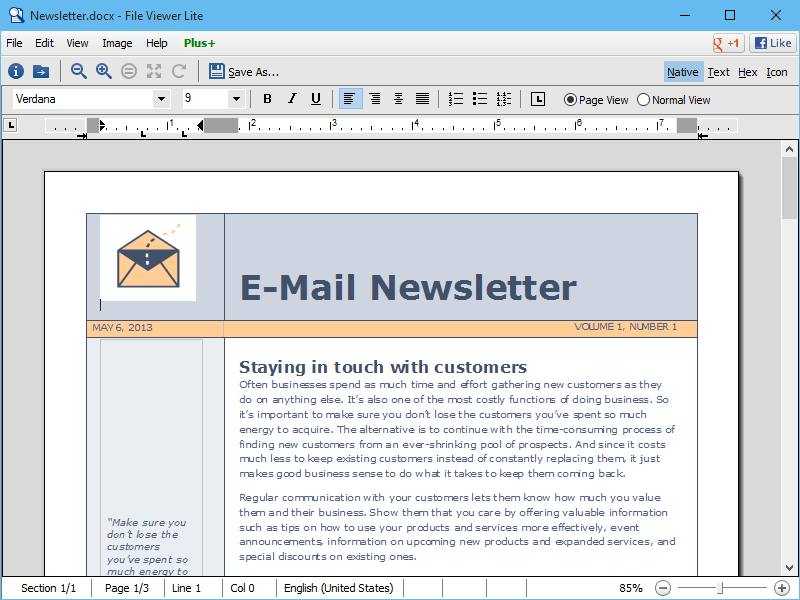 |
File Viewer Lite is a FREE program that can open Microsoft Word .DOC and .DOCX files. Download Now |
More information
File Viewer Lite is a free .DOC and .DOCX file opener that allows you to view Word documents (including .DOCM and .DOTX files) in their native format without having to purchase and install Microsoft Word. In addition to Microsoft Word files, File Viewer Lite can open over 150 file types, including Microsoft Excel spreadsheets, PDF files, images, video files, audio files, and more. You can also view unsupported proprietary document formats in Text View or Hex View. These views display the contents of the document, which can provide useful information.
To view your DOCX or DOC files, download the free file viewer and drag and drop the file onto the program window. File Viewer Lite will open the file and display the document in its native format as if you were viewing the document with Microsoft Word.
About File Viewer Lite
Windows File Viewer Lite combines the functionality of several programs into one simple utility. The program includes zoom and rotate controls for documents, PDFs, and images. It also includes media playback controls for audio and video files. In the rare case that a file format is not supported by File Viewer Lite, the program still displays useful information about the file type from FileInfo.com.
View all the features File Viewer Lite has to offer, or you can download the program for free and try it for yourself!
Updated: 01/24/2018 by
Microsoft Word is a popular word processing program used by computer users. Word can open text (.txt) files, rich text format (.rtf) files, XML (.xml) files, web page (.htm or .html) files, and all Word (.doc, .docx, .docm, and more) files.
To open these files in Microsoft Word, including files created and saved in Word, you can use any of the options below.
Double-click file
In some cases, you can double-click a file to open it in Microsoft Word. However, the file only opens in Microsoft Word if that file type is associated with Microsoft Word. Word documents, like .doc and .docx files, are associated with Microsoft Word by default. However, web page files, text, and rich text format files are often not associated with Word by default, so double-clicking these files may open in another program.
Right-click file and select program
For any file, you can choose the program to open a file with, including Microsoft Word.
- Right-click the file you want to open.
- In the pop-up menu, select the Open with option.
- If available, choose the Microsoft Word program option in the Open with menu. If Microsoft Word is not listed, select the Choose other app or Choose default program option, depending on the version of Windows on your computer.
- In the window that opens, find Microsoft Word in the program list and select that option. Microsoft Word should open and the file opened within Word.
Open within Microsoft Word
Follow the steps below to open a file from within Microsoft Word.
Word 2007 and later
- Open the Microsoft Word program.
- Click the File tab on the Ribbon and click the Open option.
- If the Open window does not appear, click the Browse option to open that window.
- In the Open window, find and select the file you want to open in Microsoft Word. You may need to click the drop-down list next to the File name text field to change the file type, and then select open.
- Click the Open button at the bottom right of the open window.
Word 2003 and earlier
- Open the Microsoft Word program.
- In the menu at the top, click the File menu and select the Open option.
- In the Open window, find and select the file you want to open in Microsoft Word. You may need to click the drop-down list next to the File name text field to change the file type, and then select open.
- Click the Open button at the bottom right of the Open window.

Read time 8 minutes
Imagine! You have put all your efforts and time into writing a great speech for an important event or a major meeting with the clients. But just a few minutes before the event, Microsoft Word shows you an error saying, “Word file won’t open.” Yes! This imaginary situation could easily become a reality for anyone, even you.
Microsoft Word continues to be the most used and reliable text processor developed by Microsoft way back in 1983 and includes various additional features like spell checkers, templates, layouts, and image formats. But it can also show an error ‘Word file won’t open.’ This error usually occurs when the user tries to open a Word document (initially created in an older version of the Word application) in the latest version. However, it could also take place due to corruption in the Word document.
Check the ‘Trust Center’ settings-
The Trust Centre settings of the Microsoft programs allow you to customize the privacy and security settings. With these settings, you can share the Word document with other users and even restrict some information. Disable the protected view settings; it can also resolve and open corrupt word DOC and DOCX files to fix the issue where the Word file would not open.
Change “Component Security” Settings
Sometimes Windows security levels prohibit users from opening the Word file. In such a situation, the user needs to set the “Component Security” settings to the default option.
Step 1- Go to the search box and type “dcomcnfg” and press the Enter key.
A new window will appear.
Step 2- Now select “Component Services” from the left pane.
Step 3- In the middle pane, go to the “Computers” and double-click over it to expand.
Step 4- Now go to the “My Computer” icon. Right-click over it and select “Properties.”
Step 5- Lastly, navigate to the “Default Properties” tab.
Step 6- Now, in the “Default Distributed Com Communication Properties,” set the “Default Authentication Level” to the Default option from the dropdown menu.
Step 7- Also set the “Impersonation level” from the to “Identify” from the Default impersonation level
Step 8- Finally, click the “Ok” button.
Utilize the ‘Open and Repair’ feature-
There is a chance that the Word file is damaged which is preventing it from opening in its usual way. But the ‘Open and Repair’ command in Word might be able to repair and recover the Word file. This feature can also Solved – A File Error has occurred in MS Word.
Convert Word file to a new format-
One of the reasons behind the issue ‘Word file won’t open’ could be the format of the document. The format could not be well compatible with a few elements of the Word file. In this case, converting the Word file to a different format could open prospects for the latest and additional features.
Change the Word file into a new format using this procedure-
Insert the document into a new one-
Any file can be inserted into a new Word document. The file that won’t open can be easily inserted into a new document, and it becomes part of it which can resolve the not opening issue. However, inserting a document leads to increasing the file size of the new Word document.
To insert the file, follow these steps-
Repair Word files using a professional approach-
If none of the methods help you to fix the ‘Word file won’t open issue, it can be concluded that the document has been severely corrupted. Repairing a corrupted file without losing any information is a critical task that needs a professional tool. Kernel for Word Repair is one such tool that can flawlessly complete the task in a jiffy. It has the ability to recover any Word file without any limitation of file size, number of files, and degree of corruption.
Follow these easy steps to repair the Word file-
Conclusion
Microsoft Word can work perfectly but suddenly display an error saying, “Word file won’t open.” However, certainly, there are methods to resolve this issue since it is a commonly used application for any type of work. There exist some ways within the Word application to fix the Word file won’t open error, including changing the Trust Center Settings, using the Open and Repair command and inserting the Word file into a new document. It can also be resolved by converting it into a new Word document format. But there is a high possibility that the Word file has gone completely corrupt. In such a situation, using a premium tool like this tool is recommended.
More Information
- How to Repair Virus Infected MS Word Files?
- How to Fix the “Document Template is not Valid” Error in MS Word?
- Fixed: “The file is Corrupted and Cannot be Opened in Word”
- 4 Methods to Recover MS Word Documents
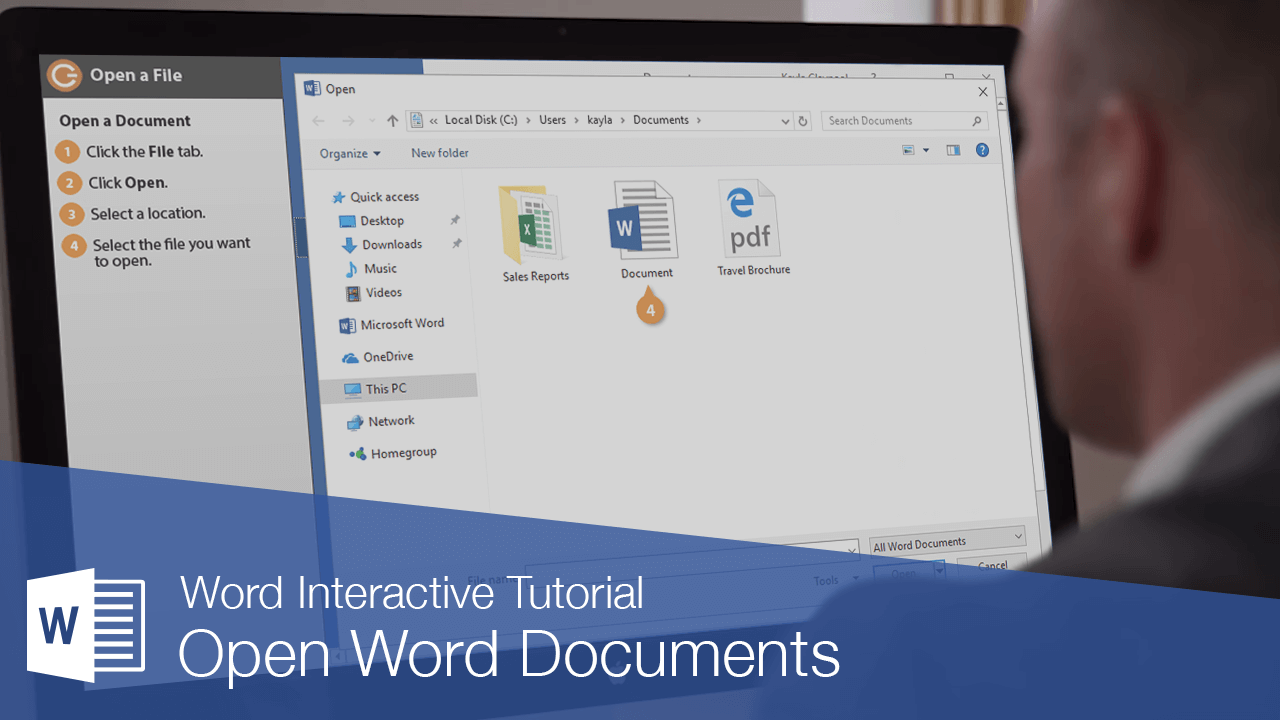
Opening a file lets you resume working on a document that you have saved from earlier or that someone else has created and shared with you.
Open a Document
While you can open a document by double-clicking its icon in Windows, you can also browse and open files from within Word.
- Click the File tab.
- Click Open.
The Open screen appears, giving you a few ways to find a document.
- Select a location.
- Recent displays a list of documents that you’ve recently opened.
- Shared with Me will show documents that others have shared with you through your Office 365 account.
- Your OneDrive and SharePoint sites will let you browse through the files stored on those cloud servers, if you have them.
- This PC lets you browse through the Documents folder for files.
- Clicking Browse opens a dialog box, where you can browse through your computer’s folders, drives, and network shares.
- Select the file you want to open.
The selected file opens.
From the Browse dialog box, you’ll need to click the Open button after selecting the file.
Open a PDF for Editing
In addition to opening Word’s regular file formats, you can also open PDF documents for editing.
- Click the File tab.
- Click Open.
- Select and open a PDF file.
A dialog box appears, explaining that opening a PDF in Word converts it to a Word document and opens it as a copy. You’ll be able to edit the text, but some formatting and graphics may look different.
- Click OK.
A copy of the PDF is converted into an editable document, and it opens so that you can edit the text.
FREE Quick Reference
Click to Download
Free to distribute with our compliments; we hope you will consider our paid training.





